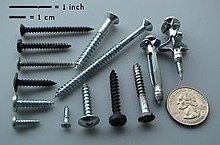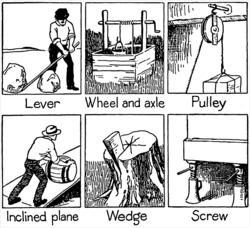


A screw is an externally helical threaded fastener capable of being tightened or released by a twisting force (torque) to the head. The most common uses of screws are to hold objects together and there are many forms for a variety of materials. Screws might be inserted into holes in assembled parts or a screw may form its own thread.[1] The difference between a screw and a bolt is that the latter is designed to be tightened or released by torquing a nut.
The screw head on one end has a milled slot that commonly requires a tool to transfer the twisting force. Common tools for driving screws include screwdrivers, wrenches, coins and hex keys. The head is usually larger than the body, which provide a bearing surface and keeps the screw from being driven deeper than its length; an exception being the set screw (aka grub screw). The cylindrical portion of the screw from the underside of the head to the tip is called the shank; it may be fully or partially threaded with the distance between each thread called the pitch.[2][3]
Most screws are tightened by clockwise rotation, which is called a right-hand thread.[4][5] Screws with a left-hand thread are used in exceptional cases, such as where the screw will be subject to counterclockwise torque, which would tend to loosen a right-hand screw. For this reason, the left-side pedal of a bicycle has a left-hand thread.[6]
The screw mechanism is one of the six classical simple machines defined by Renaissance scientists.[7][8][9]
- ^ Oberg et al. 2000, p. 1492
- ^ Smith 1990, p. 39.
- ^ Blake, A. (1986). What Every Engineer Should Know about Threaded Fasteners: Materials and Design. Taylor & Francis. p. 9. ISBN 978-0-8493-8379-3. Retrieved 2021-01-24.
- ^ McManus, C. (2002). Right Hand, Left Hand: The Origins of Asymmetry in Brains, Bodies, Atoms and Cultures. Harvard University Press. p. 46. ISBN 978-0-674-01613-2.
- ^ Anderson, J.G. (1983). Technical Shop Mathematics. Industrial Press. p. 200. ISBN 978-0-8311-1145-8.
- ^ Brown, Sheldon. "Bicycle Glossary: Pedal". Sheldon Brown. Retrieved 2010-10-19.
- ^ Anderson, William Ballantyne (1914). Physics for Technical Students: Mechanics and Heat. New York: McGraw Hill. p. 112. Retrieved 2008-05-11.
- ^ "Mechanics". Encyclopædia Britannica. Vol. 3. John Donaldson. 1773. p. 44. Retrieved 5 April 2020.
- ^ Morris, Christopher G. (1992). Academic Press Dictionary of Science and Technology. Gulf Professional Publishing. p. 1993. ISBN 978-0122004001.